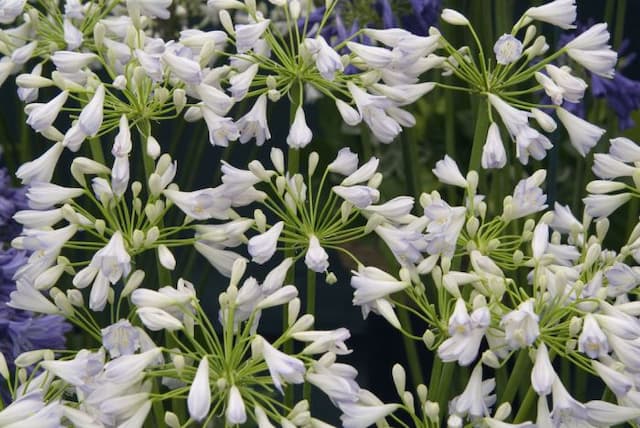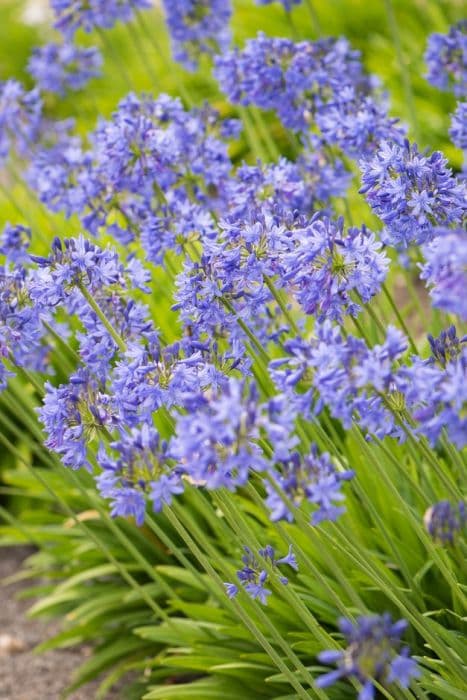African Lily Agapanthus 'Timaru'

ABOUT
Agapanthus 'Timaru' is a striking ornamental plant commonly known as the African Lily or Lily of the Nile. It possesses a clump-forming habit, showcasing dense tufts of strappy, dark green leaves that gently arch outwards. The foliage provides a lush, grass-like appearance at the base, setting an elegant backdrop for its most captivating feature: the flowers. Blossoming in the warmer months, this plant produces tall, erect stalks topped with large, rounded clusters of funnel-shaped blooms. Each cluster, referred to as an umbel, is a magnificent globe of starry flowers, typically in shades of a deep, vibrant blue—a color that can give the impression of a fireworks display in the garden. The individual flowers are trumpet-like, with a subtle elegance that belies their hardy nature. They emerge from their buds in succession, with each cluster maintaining its ornate display for several weeks. These blooms are not only a feast for the eyes but are also known to attract pollinators like bees and butterflies, adding a dynamic element to their visual appeal. When not in bloom, African Lily 'Timaru' continues to offer textural interest with its persistent greenery, making it a versatile choice for gardeners. It's often utilized in borders, as a focal point in a mixed bed, or even in containers, where its dramatic flower stalks can rise and captivate onlookers. Despite its exotic appearance, the African Lily is notably durable, able to withstand a variety of conditions, though it truly thrives and performs best when given optimal care and an appropriate setting.
About this plant
 Names
NamesFamily
Amaryllidaceae
Synonyms
African Lily, Lily of the Nile, Love Flower
Common names
Agapanthus 'Timaru'.
 Toxicity
ToxicityTo humans
The Agapanthus, commonly known as the African Lily, has parts that are considered toxic if ingested by humans. All parts of the plant contain toxic substances, with the highest concentration typically found in the roots and sap. If eaten, the African Lily can cause symptoms such as nausea, vomiting, abdominal pain, and diarrhea. In some cases, skin contact with the sap can result in irritation or dermatitis. It's important to handle the plant with care and ensure that children do not ingest any part of it.
To pets
The African Lily is also toxic to pets such as dogs and cats. If a pet ingests any part of the African Lily, they may experience symptoms including nausea, vomiting, drooling, diarrhea, and abdominal pain. In severe cases, it could lead to more serious effects like tremors or an allergic reaction. Pet owners should keep the African Lily out of reach of their animals to prevent accidental ingestion.
 Characteristics
CharacteristicsLife cycle
Perennials
Foliage type
Evergreen
Color of leaves
Green
Flower color
Blue
Height
2 feet (60 cm)
Spread
2 feet (60 cm)
Plant type
Bulb
Hardiness zones
8
Native area
South Africa
Benefits
 General Benefits
General Benefits- Ornamental Value: Agapanthus 'Timaru', commonly known as Lily of the Nile, is valued for its striking blue or purple flowers that add aesthetic appeal to any garden or landscape.
- Drought Tolerance: Once established, it is quite drought-tolerant, making it suitable for xeriscaping or regions with water scarcity.
- Low Maintenance: It requires minimal care beyond the occasional watering and fertilizing, making it an ideal plant for gardeners of all skill levels.
- Long Blooming Season: The Lily of the Nile has a lengthy blooming period that lasts from midsummer to early fall, offering a sustained display of color.
- Attracts Pollinators: Its blossoms attract bees and butterflies, which are beneficial for pollinating garden plants and maintaining a healthy ecosystem.
- Container Planting: It is suitable for container planting, allowing those with limited space to enjoy its beauty on patios, balconies, and other small areas.
- Rabbit Resistant: This plant is notably resistant to rabbits, so it is less likely to be damaged by these garden visitors.
- Border Planting: Due to its clumping nature and attractive foliage, it is ideal for use in borders and as a structural plant in garden designs.
- Frost Hardy: Agapanthus 'Timaru' can withstand light frosts, making it suitable for a variety of climates.
 Medical Properties
Medical PropertiesThis plant is not used for medical purposes.
 Air-purifying Qualities
Air-purifying QualitiesThis plant is not specifically known for air purifying qualities.
 Other Uses
Other Uses- Edging for pathways: Agapanthus can be planted in rows to create a natural and attractive edge along garden paths or walkways.
- Erosion control: The root system of Agapanthus helps to stabilize soil and can be useful for preventing erosion on slopes or in areas prone to the loss of topsoil.
- Rain garden plants: Due to their ability to tolerate moist conditions, Agapanthus plants can be included in rain gardens to absorb excess rainwater and reduce runoff.
- Dye production: The flowers of the Agapanthus can potentially be used to create natural dyes for fabrics or crafts.
- Garden sculptures: When dried, the seed heads of Agapanthus can be used to create interesting shapes and textures for garden sculptures or decorative elements.
- Photography subject: Because of their striking flowers, Agapanthus plants are frequently used as the subject of garden photography and art pieces.
- Culinary garnish: While not widely known as an edible plant, the blooms of Agapanthus can sometimes be used as a decorative garnish in culinary presentations.
- Biological pest control: The dense foliage of Agapanthus can provide habitat for predator insects that help control garden pests naturally.
- Companion planting: Agapanthus can be strategically planted near vegetable gardens to attract pollinators, aiding in the pollination of crops.
- Wedding decor: The elegant and showy Agapanthus blooms can be incorporated into floral arrangements and decorations for weddings and other events.
Interesting Facts
 Feng Shui
Feng ShuiThe Lily of the Nile is not used in Feng Shui practice.
 Zodiac Sign Compitability
Zodiac Sign CompitabilityThe Lily of the Nile is not used in astrology practice.
 Plant Symbolism
Plant Symbolism- Love Letters: The name "Agapanthus" is derived from the Greek words 'agape' meaning love, and 'anthos' meaning flower. Therefore, it commonly symbolizes love and is often referred to as the "flower of love."
- Beauty: Agapanthus is admired for its striking blue flowers and elegant appearance, making it a symbol of beauty and a popular choice in gardens.
- Endurance: With its ability to survive with minimal care and still produce stunning blooms, agapanthus represents endurance and perseverance.
- Fertility: The lush foliage and abundant flowers of the agapanthus plant can symbolize fertility and prosperity in various cultural contexts.
- Home: Agapanthus, often used in domestic gardens and landscaping, is believed to symbolize a happy home and the feeling of domestic bliss.
 Water
WaterFor the Lily of the Nile, consistent moisture is key, especially during the growing season. Water the plant thoroughly, ensuring the soil is damp but not waterlogged. During the summer, water about once a week, providing about 1 to 1.5 gallons per plant, depending on weather conditions. Reduce watering frequency in the winter when the plant is dormant, but do not let the soil completely dry out. It's critical to avoid overwatering as this can lead to root rot.
 Light
LightThe Lily of the Nile thrives in full sun to partial shade conditions. For optimal growth, place the plant in a location where it will receive at least six hours of direct sunlight each day. However, it can tolerate some light afternoon shade, particularly in hot climates. Avoid deep shade as it can inhibit flowering and weaken the plant.
 Temperature
TemperatureThe Lily of the Nile prefers temperatures between 50°F and 90°F. It can withstand brief periods as low as 25°F, but sustained cold can damage the plant. Ideal growing conditions are achieved when nighttime temperatures don't drop below 50°F, which promotes healthy growth and flowering. Protect the plant from frost by bringing potted specimens indoors or providing protection outdoors.
 Pruning
PruningPrune the Lily of the Nile to remove spent flower stalks and to encourage new growth and reblooming. The best time to prune is after flowering has finished, usually in late summer or early fall. Cut the stalks down to the base of the plant. Additionally, you can remove any damaged or yellowing leaves to maintain the plant's appearance and health.
 Cleaning
CleaningAs needed
 Soil
SoilLily of the Nile thrives in a well-draining soil mix with compost and sand for added drainage. They prefer soil pH between 6.0 to 7.0.
 Repotting
RepottingLily of the Nile should be repotted every 2 to 3 years or when rootbound to maintain its health and vigor.
 Humidity & Misting
Humidity & MistingLily of the Nile prefers moderate humidity levels but is adaptable to various indoor humidity conditions.
 Suitable locations
Suitable locationsIndoor
Place Lily of the Nile in bright indirect light and well-draining soil.
Outdoor
Plant Lily of the Nile in full sun to partial shade in fertile soil.
Hardiness zone
8-10 USDA
 Life cycle
Life cycleThe Agapanthus 'Timaru', commonly known as Lily of the Nile or African Lily, begins its life cycle as a dormant rhizome or seed that germinates when environmental conditions are favorable—typically in spring. After germination, it enters a vegetative growth phase, characterized by the production of long, strappy leaves that form a dense clump. As the plant matures, it develops a thickened root system that stores energy for future growth. During the flowering stage, typically in the summer, it sends up tall, sturdy stalks topped with globe-shaped clusters of blue or white trumpet-shaped flowers. After pollination, the flowers produce seed capsules containing seeds that can be dispersed, completing the reproductive cycle. During the fall or as conditions become less favorable, the Agapanthus 'Timaru' may enter a period of dormancy, with the foliage dying back and the plant conserving energy in its roots for the next growing season.
 Propogation
PropogationPropogation time
Spring-Summer
Propogation: Agapanthus 'Timaru', commonly known as Lily of the Nile, is best propagated through division, which is an effective and popular method of creating new plants. The ideal time to propagate by division is in the spring or early summer, when the plant is beginning to grow actively. To propagate, carefully lift the clump of the plant from the ground using a garden fork, taking care not to damage the roots. Once out of the ground, divide the clump into smaller sections by either gently pulling the plant apart with your hands or cutting through the rhizomes with a sharp knife. Each section should have at least one or two growing points or shoots. Replant the divisions at the same depth they were originally growing, spacing them about 18 inches (approximately 45 centimeters) apart to allow for growth. Water the new plants thoroughly to establish them.









![African lily [Brilliant Blue]](/_next/image?url=https%3A%2F%2Fplants-admin.emdemapps.com%2Fimages%2Fplants%2F%2Fimages%2F604b5e3c28e2b.png&w=640&q=75)